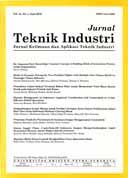A Multi-Item Probabilistic Inventory Model that Considers Expiration Factor, All Unit Discount Policy and Warehouse Capacity Constraints
DOI:
https://doi.org/10.9744/jti.23.2.139-148Keywords:
probabilistic inventory model, all unit discount, perishable, warehouse capacityAbstract
The characteristics considered in this study are probabilistic demand, perishable products, and warehouse constraints for multi-item inventory models. This condition occurs in several industries that consider perishable factors and warehouse constraints, namely companies that produce food, food sales agents, and retail that sell goods to end customers. The Karush-Kuhn-Tucker Condition approach was used to solve the warehouse capacity problem to find the optimum point of a constrained function. The results of the developed inventory model provide two optimal ordering times, namely ordering time-based on warehouse capacity and joint order time, and the two ordering time values will be compared to determine which ordering time is optimal. In addition, the sensitivity analysis to the model was done to analyse the total inventory costs in a planning horizon, the time between goods ordering from one cycle to the next cycle, and the number of items that will expire. The parameters to be changed for the sensitivity test were warehouse constraint, a fraction of good condition goods, holding costs per unit per period, and all unit discount factors. The sensitivity analysis was done to see the behaviour of the total cost, time to order changes, and the quantity of perished products. The result of model testing and sensitivity analysis showed that total cost, based on joint order, is sensitive to the fraction of good condition products, discount, and holding cost. The joint order was not sensitive to the warehouse capacity. In general, the model was perceived as able to describe the behaviour of the model components.
Downloads
References
Karteek, P.H., and Jyoti, K., Deterministic and Probabilistic Models in Inventory Control. Department of Mechanical Engineering, Gayatri Vidya Parishad College of Engineering, Visakhapatnam, India, 2014.
Koswara, H., and Lesmono, D., Penentuan Waktu antar Pemesanan Optimal untuk Model Persediaan Probabilistik Multi Item dengan All-Units Discount dan Kendala Kapasitas Gudang, Performa, 17(1), 2018, pp. 1:1-6.
Bahagia, S. N., Sistem Inventori. Penerbit ITB, Bandung, 2006.
Hunusalela. Z. F., Model Inventory Perishable Material dengan Mempertimbangkan Faktor Kapasitas Gudang Penyimpanan Bahan Baku PT. So Good Food Manufacturing, Jurnal Teknik Industri, Universitas Indraprasta PGRI.
Lesmono, D., and Limansyah, T., Model Persediaan Multi Item dengan Mempertimbangkan Faktor Kedaluwarsa dan Faktor All-Unit Discount, Jurnal Teknik Industri, 3(2), 2011, pp 87-94.
Silitonga, R. Y. H., and Kawet, M. P., Pengembangan Model untuk Aplikasi Pengendalian Persediaan Probabilistik Multi Item Single Supplier, Jurnal Telematika, 12(1), 2017, pp. 13-22.
Limanjaya, B., and Silitonga, R. Y. H., Development of Multi-Item Probabilistic Inventory Model by Considering Perishable and Purchase Bonus Factors, Jurnal Telematika, Edisi Khusus IESC 2018, pp. 54-59.
Lesmono, D., Limansyah, T., Loedy, N., A Joint Return Policy for a Multi-Item Perishable Inventory Model with Deterministic Demands, Return, and All-Units Discount, International Journal of Mathematical, Engineering and Management Sciences, 5(3), 2020, pp. 416-431.
Jaggi, C. K., Sharma, A., and Mittal, M., A Fuzzy Inventory Model for Deteriorating Items with Initial Inspection and Allowable Shortage under the Condition of Permissible Delay in Payment, International Journal of Inventory Control and Management, Special Issue on International Conference on Applied Mathematics & Statistics, December 2011.
Hidayat, Y. A., Riaventin, V. N., and Jayadi, O., Economic Order Quantity Model for Growing Items with Incremental Quantity Discounts, Capacitated Storage Facility, and Limited Budget, Jurnal Teknik Industri, 22(1), 2020, pp. 1-10.
Wibisono, A., Prassetiyo, H., and Fitria, L., Rancangan Sistem Persediaan Bahan Baku Produk Baju dan Celana Menggunakan Model Persediaan Q Probabilistik dengan Kendala Luas Gudang (Studi Kasus di PT Cipta Gemilang Sentosa), Jurnal Online Institut Teknologi Nasional, 2(3), 2014, pp.1-10.
Utama, D. M., Penentuan Lot Size Pemesanan Bahan Baku dengan Batasan Kapasitas Gudang, Julnal Ilmu Teknik Industri, 15(1), 2016, pp.64-68
Lesmono, D., Limansyah, T., A Multi Item Probabilistic Inventory Model, IOP Conf. Series: Journal of Physics 893, 2017.
Tersine, R. J., Principles of Inventory and Materials Management, 4th edition, PTR Prentice-Hall, NJ07458, 1994.
Silitonga, R. Y. H., and Jelly, N., An Impact Analysis of Forecasting Methods and Forecasting Parameters on Bullwhip Effect, IOP Conf. Series: Materials Science and Engineering 337, 2018.
William, T. J. Ai, and Lee, W., An Inventory Model to Control Multi-Item Medicines with Consideration of Space Capacity in the Hospital and Joint Replenishment, International Journal of Industrial Engineering and Engineering Management, 2(2), 2020, pp. 39-48.
Ardiansyah, H., Gani Gunawan., and Respitawulan., Optimasi Fungsi Nonlinear Dua Variabel Bebas dengan Satu Kendala Pertidaksamaan Menggunakan Syarat Khun-Tucker, Departemen Matematika. Prosiding Matematika, vol 2, No. 2. ISSN: 2460-6464, 2016.
Fergany, H. A., Probabilistic Multi-Item Inventory Model with Varying Mixture Shortage Cost Under Restrictions, Springer Plus, 2016.
Downloads
Published
How to Cite
Issue
Section
License
Articles published in the Jurnal Teknik Industri: Jurnal Keilmuan dan Aplikasi Teknik Industri will be Open-Access articles distributed under the terms and conditions of the Creative Commons Attribution License (CC BY).
![]()
This work is licensed under a Creative Commons Attribution License (CC BY).



















